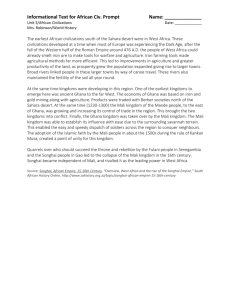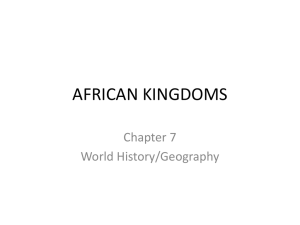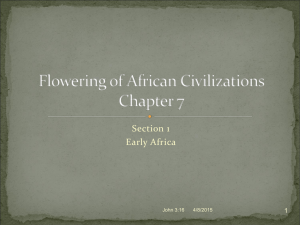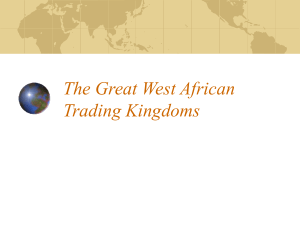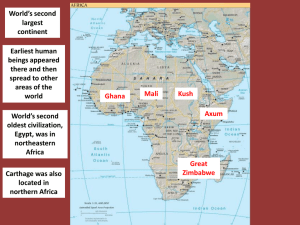African Civilizations: c. 800-1600 CE
advertisement
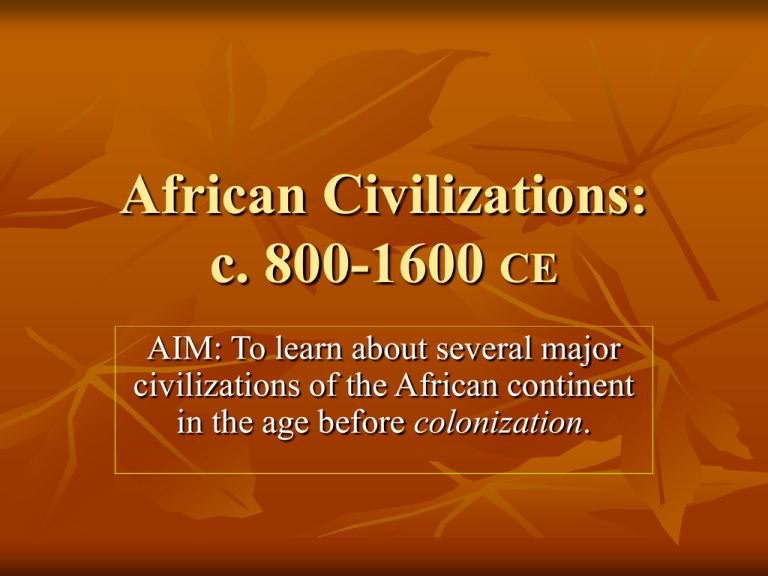
African Civilizations: c. 800-1600 CE AIM: To learn about several major civilizations of the African continent in the age before colonization. 3 Big Ideas About Africa, pre-1600: The continent became part of the global trade network through West & East African trading states. African peoples were introduced to Islam. African people maintained traditions around their village, family, and religious belief (s). Basic Geography of Africa Second largest continent on Earth, after ________ Much of Africa is made up of savanna—or ________________. A large part of Africa is also desert—including the _________, the world’s largest desert. __________ run along the Equator in central Africa. Fertile farmland is scattered throughout the continent—although __________ are a persistent problem in places (i.e. Somalia). Natural Resources Natural Resources Africa is filled with many natural resources that are traded worldwide: oil (i.e. Nigeria is the 11th largest producer of crude oil in the world); diamonds (i.e. especially from South Africa & Botswana); salt; iron; gold; copper; etc. Government, pre-1600 Most African communities traditionally shared… _________________presented opinions and arguments before everyone else joined in to reach a _____________. Traditional Society & Culture, pre1600 GOVERNMENT Most African communities traditionally shared power among members of the community rather than having a single leader. Elders and other respected people presented opinions and arguments before everyone else joined in to reach a consensus. Family Patterns Traditional African societies emphasized the ____________ over the ____________. Therefore, extended families who descended from a common ancestor formed ________, or a group of people __________________. Family Patterns Traditional African societies emphasized the group over the individual. Therefore, extended families who descended from a common ancestor formed clans, or a group of people united by a common trait or interest. Some art from the Smithsonian’s collection at the National Museum of African Art, in D.C. Yoruba peoples, Ekiti region, Nigeria Early 20th century wood, pigment Baule peoples, Côte d'Ivoire 19th century wood, encrustation Basic Traditional Religious Beliefs Many early Africans identified the forces of nature with divine spirits and worshipped many gods and goddesses, making them _____theistic. Many Africans also believed the spirits of their departed ancestors were present here on Earth. Animism: Some of these early religious beliefs were animistic. Today, some people in Africa (and elsewhere around the world) are still animistic, but may also combine these beliefs with a more formal religion such as Christianity [this is called syncretism]. Animism: The belief in the existence of individual spirits that inhabit natural objects and phenomena. Some of these early African peoples believed in one supreme being who was the creator and ruler of the universe. In Botswana, many people have a totem, or a natural object or animal associated with a particular family, person, or clan. [Do Not Write] I was given the totem of a “kwena,”or crocodile. One respects one’s totem and feels some connection to it, as well. 3 Major Kingdoms of West Africa ~ ~ ~ 3 trading kingdoms of West Africa: The Rise and Fall of African Kingdoms Strong African rulers created kingdoms by gaining control of the most profitable trade routes. 3 trading kingdoms of West Africa were: Ghana, Mali, and Songhai. Kingdom of ___________ Location: General facts/history: Resources/economy/trading: Decline: Kingdom of Ghana [from www.bbc.co.uk] 800-1000 CE Despite its name, the old Empire of Ghana is not geographically, ethnically, or in any other way, related to modern Ghana. It lies about four hundred miles northwest of modern Ghana. Ancient Ghana encompassed what is now modern Northern Senegal and Southern Mauritania. [Do Not Write] Nobody is sure when Ghana came into being. But some time at the beginning of the first millennium AD, it is thought that a number of clans of the Soninke people, (in modern Senegal) came together under a leader with semi-divine status, called Dinga Cisse. There are different accounts of who he was, but all reports emphasize that he was an outsider who came from afar. It is likely that this federation of Soninke was formed possibly in response to the attacks of nomadic raiders, who were in turn, suffering from drought, and seeking new territory. Further west was the state of Takrur in the Senegal valley. It was linked to the north via a coastal route leading to Morocco via Sjilmasa. The Empire of Ghana derived power and wealth from gold. The introduction of the camel in trans-Saharan trade boosted the amount of goods that could be transported. Most of our knowledge of Ghana comes from Arab writers. Al-Hamdani, for example, describes Ghana as having the richest gold mines on earth. These were situated at Bambuk, on the upper Senegal River. The Soninke also sold slaves, salt and copper, in exchange for textiles, beads and finished goods. Muslim merchants brought their religion and ideas when they settled in the kingdom of Ghana. Ghana absorbed Muslim cultural influences, such as Arabic writing and Muslim styles of architecture. Women in Ghana had a high status and played an active role in the economic life of the empire. Decline There were a number of reasons for Ghana's decline. The King lost his trading monopoly. At the same time drought was beginning to have a long term effect on the land and its ability to sustain cattle and cultivation. But the Empire of Ghana was also under pressure from outside forces. Kingdom of ___________ General history/facts/location: Government: Trading fact: Decline: Kingdom of Mali 1200-1450 CE Under Sundiata Keita (aka Mansa Musa), the most powerful ruler of early Mali, the kingdom extended its borders and dominated West Africa. Mansa Musa ran an efficient government— appointing governors to rule certain areas. Mansa Musa converted to Islam and took a hajj to Mecca. This hajj had a cultural impact on Mali since Mansa Musa brought home Muslim scholars and artists and forged new trading ties. Decline [do not write] A combination of weak and ineffective rulers and increasingly aggressive raids by Mossi neighbors and Tuareg Berbers gradually reduced the power of Mali. In the east, Gao began its ascendancy while remaining part of the Mali Empire. ridges served with a variety of "sauces." These sauces can be made with peanuts, okra, baobab leave Kingdom of ____________ General history/location: Government: Government: Resources/trade: Decline: Kingdom of Songhai 1450-1600 CE Emperor Sonni Ali built Songhai into the largest state that had ever existed in West Africa. An efficient bureaucracy governed the kingdom. The Songhai expanded trade to Europe & Asia. As in Mali, there was a privileged caste of craftsmen, and slave labor played an important role in agriculture. Trade improved under the ruler Mohammed Ture Askiya, with gold, kola nuts and slaves being the main export. Textiles, horses, salt and luxury goods were the main imports. Decline Civil war broke out in the late 1500s. Invaders from the north defeated disunited forces of Songhai, leading to the kingdom’s downfall. Hausa People: A Synopsis Nubia: A Synopsis Hausa people 1300s The Hausa people built city-states (like early versions of minicountries) in what later became Nigeria. Hausa products made from cotton and leather traveled on caravans across the Sahara and sometimes to Europe. The Hausa dominated Saharan trade routes by the 1500s. Nubia: 1000 BCE-150 CE [Do Not Write] When discussing the civilizations of the Nile Valley, many histories focus almost exclusively on the role of Egypt. But this approach ignores the emergence further south on the Nile of… [Start Writing…] …the kingdom known to the Egyptians as Kush, in the region called Nubia - the area now covered by southern Egypt and Northern Sudan. Nubia was rich with minerals such as stones needed for the building of temples and tombs, and gold, needed for jewelry. Indeed Kush was one of the major gold producers of the ancient world. At one stage Nubia, was occupied by Egypt for about 500 years and then the tables turned. From around 850 BCE, the Egyptian state fell into such decline that what became known as the 25th dynasty rose in Nubia, with authority over all of Egypt. Decline Around 350 CE, King Ezana of Axum invaded Nubia. East Africa Overview [Do Not Write] In contrast to North Africa, East Africa was never subject to one wide, sweeping Muslim takeover. Islam came to the East African coast in many waves and at different times. There is no single date in the records, but it is thought that Islam had taken root by the 8th century. [Do Not Write] The first Muslims came from different directions. Most obviously from the Arab peninsula, which at one point is separated by less than fifty miles of sea from the Horn of Africa. They came from Egypt, where Islam first came to North Africa, and from Somalia further up the coast, where the port of Zeila became very important in the 10th century in response to the political centre of the Muslim world moving from Mecca to Baghdad. And finally Persia; there is a tradition that the first Muslims came from Shiraz in Persia. They are known as the Shirazis. AXUM: A Synopsis Axum [aka Aksum]: 900 BCE-600 CE source: encarta.com Only write points 1 & 3 Aksum, ancient kingdom that flourished in northeastern Africa from the 1st century BC until the early 7th century AD. Its capital was the city of Aksum, which lies in the northern part of present-day Ethiopia. A powerful trading center, Aksum controlled the highlands of northern Ethiopia and the Red Sea coast of present-day Eritrea. Culturally, it was closely associated with the people of southern Arabia, who spoke related languages and followed similar traditions. Aksumite kings built massive stelae (stone pillars) to adorn their tombs, and some of these stelae still stand today. Traders who had immigrated from Arabia mixed with African farmers, thereby introducing Jewish and Christian traditions to Axum. Fremnatos—trader, philosopher, theologian, saint He introduced Christianity to Axum, after supposedly being kidnapped there while on his way to India. King Ezana learned from Fremnatos and adopted his faith as Axum’s official religion in 333 CE. Decline Axum declined due to civil war. Great Zimbabwe Great Zimbabwe, historic city in southern Africa that was established in the 11th century CE and flourished for about 300 years beginning in the 12th century. At its height the city dominated much of the present-day country of Zimbabwe. By the end of the 15th century the city had fallen into disuse and was largely abandoned.


